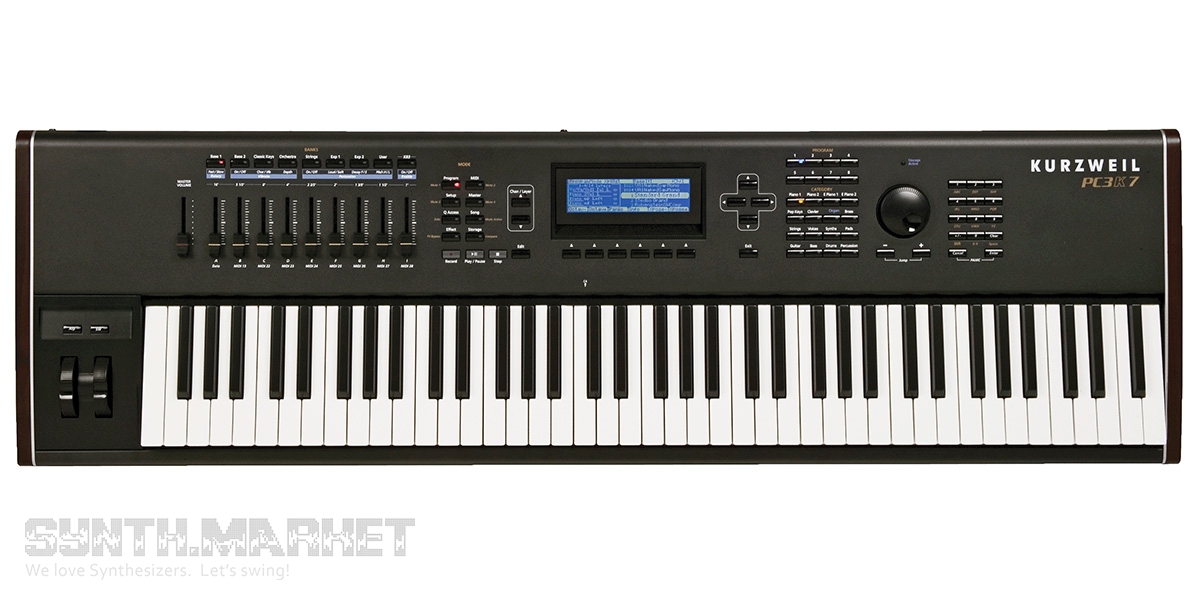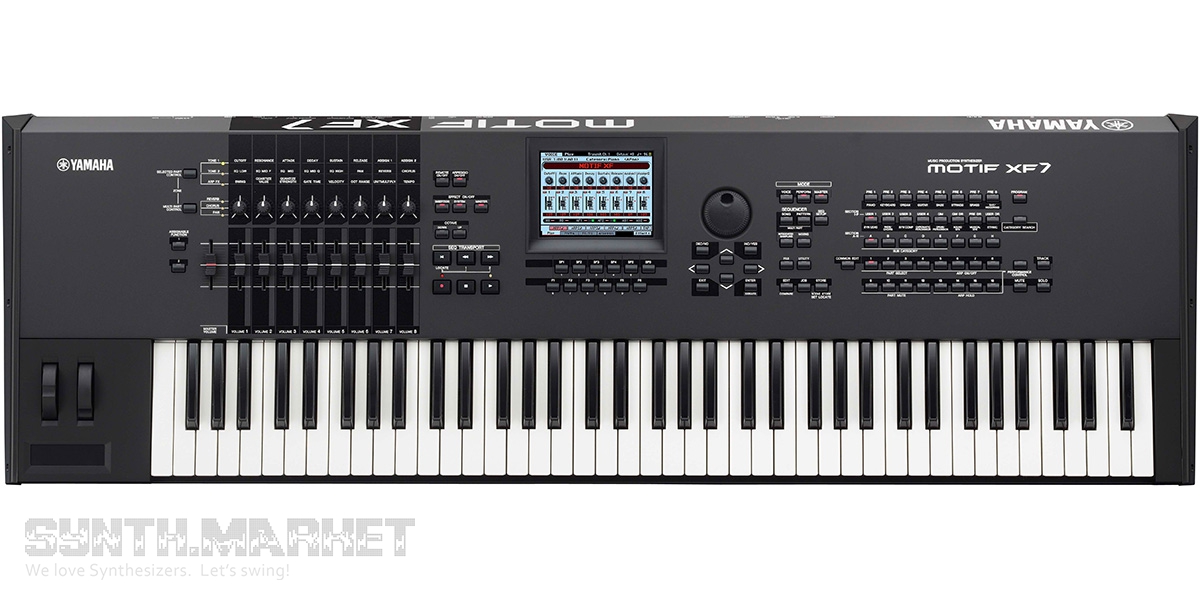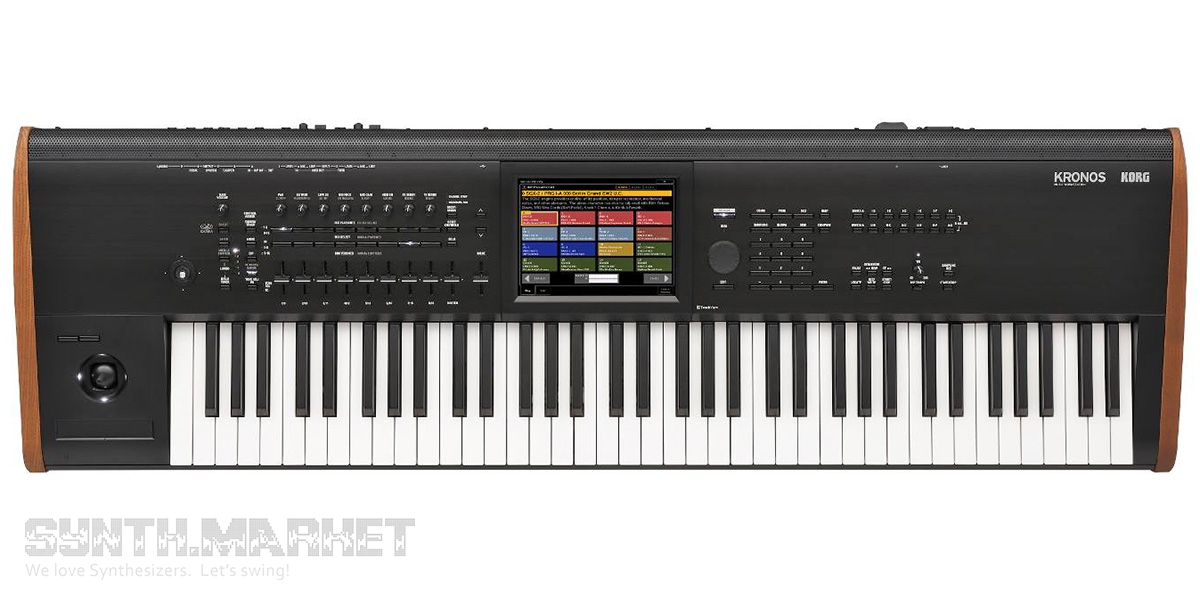Besides Dynamic VAST, PC3K architecture comprises VA-1 sound engine – this analog modeling synth was devised in the 2000s but didn’t make it through the “prototype” stage, i.e. never made it into production. The engine instead made it into the PC3X. VA-1 functions thanks to virtual analog oscillators which allow achieving genuinely realistic voices. Moreover, PC3K offers a cascade mode which allows routing any layer through another already processed (DSP) layer in series or by mixing (up to 32 layers).
PC3K replicates many features of the PC3X system offering a 128-note polyphony and 16-part multitimbrality but now it also supports sample playback (128Mb) - samples are non-volatile and after the synth is switched back on, you’ll find them as they were. PC3K also sports a more effective way of storing and uploading of information via USB. PC3K lets you upload 8 and 16 bit AIFF and WAV files up to 96kHz and even if the original quality leaves much to be desired they would sound great if you put them through the brand settings. Another advantage of Kurzweil PC3K which for someone may appear to be a disadvantage is its complex structure of insert/auxiliary/master-effects allowing a user to sculpt the sound any possible way but you can explore all the editing versatility only if you delve into the details offered by these difficult guys from Kurzweil. Although if you dare to dive into the very depths of the workstation you’ll understand why the latest instruments made by the company – PC3K series – successfully entered a serious competition confronting those brands which feature a much more intuitive navigation.
К2000/2500/2600 sounds can get fully accessible for PC3K – programs and setups as well as cards and samples are compatible and can be imported. The instrument delivers the most sophisticated nuances of an electric and grand pianos (considering that the texture can carry up to 32 layers). The synthesizer features a KB3 mode (tone generator emulation), but because of the modernized parameters and DSP modeling not every uploaded sound will be available in this mode. Anyway PC3K traditionally keeps on luring the clients to its side supplying them with the features no one can resist – great sound (with the emphasis on piano, vintage keys, orchestra and synth sounds) + its excellent processing abilities.
As for the disadvantages let’s mention the insufficient number of factory presets – modern devices should definitely have more – only 4 audio outputs which is not so much for a studio use and that makes us resort to audio sample upload. VAST processing and digital audio output compensate the limitations. The small monochrome display seems to be outdated as well as the confusing and tangling menu diving makes us a little bit upset. But there are the keyboards of high quality made by famous Italian keybed maker Fatar – fully weighted TP40-L for a 7-octave version PC3K8, semi-weighted TP8 for a 6-octave PC3K7 and a synthesizer type Fatar TP9 for a 5-octave PC3K6. All the keyboards are dynamic and feature aftertouch. You can also apply an external touch sensitive programmable ribbon controller.
If you don’t want to spend money on the pricey PC3K pay attention to the PC3A and PC3LE series performance controllers. They’ve got no sampler inside and differ a bit in the number of presets and the interface, aren’t fully compatible with K2 series but cost less and allows you to have the crucial component of the concept – this extremely detailed sound settings with the help of Dynamic VAST as well as the professional use features for studio and stage. PC3A initially sports KORE 64® sound engine onboard which is a premium option for PC3K.
Considering that Kurzweil has switched into Forte/ Artis series making PC3K workstations may not get direct successors anymore so you should hurry if you want to buy it. The prices start at $2500. Never ever top workstations could have been purchased for such a kind price!
In 2010 Motif XF came out – the top of the pops, well, the culmination of Yamaha Motif series. Unlike Kurzweil instruments which are more prone to appearing on stage and aimed at a live performance, XF seems to be an all-purpose instrument maintaining the traditions of its predecessors and leading the Motif series in triumphal procession.
Crawling up the Motif series top Yamaha had a significant leap from XS – already serious enough – to XF: giving it a flash memory expansion possibility up to 2Gb; 741Mb ROM, 3977 waveforms, replaced mLAN with FW16E Firewire (16 audio channels, 3 MDI ports) interface available as an expansion board; captured 4 banks 128 user programs (Voices) each and 4x128 performances. A performance could embrace up to 4 programs and each would have its own effects and arpeggiator settings which – it’s also enriched with preset phrases (about 7800 in XF). The sound engine is the old good AWM2 which now features XA (Expanded Articulation) and VCM (Virtual Circuitry Modeling – modeled circuitry based on analog components).
The keyboard quality gives way (a little) to the Kurzweil PC3K keys – except the 7-octave version XF8. Despite the 96kHz support the converters on the XF's audio inputs and outputs max out at 44.1kHz, anyway XF allows Motif sounds interaction with tracks created in your DAW which have already been recorded at a higher resolution enabling though the real time conversion. Yamaha succeeded in connectivity between workstations and computers: starting with ES, Motif offers two USB (one for MIDI and second for the other devices), both don’t cause any problems. An expanded sample memory brought in many new and improved samples in various categories including Natural Grand S6, Clavinet D6; Vox and Farfisa organs, strings section, different wind, orchestra and bass (lower frequencies stunning quality), synth and drum sounds (including Yamaha Oak and Maple drums).
Samples saved into flash memory have to be processed in DAW because the editing of rhythm or playback mode parameters will be unavailable. A sample (or a Waveform) should belong to internal memory in order to be altered. Motif XF offers 2 proprietary standard slots for library expansion which support 512 and 1024 Mb cards; as well as 128Mb of internal SD-RAM for the sampler and 16-track sample-sequencer.
Motif XF is a de facto standard of a studio workstation. If you’re lucky to have it you know that you wouldn’t want anything else and if you’re still thinking of buying it – well, do it. It allows you to create whatever hits your mind; it’s all you wanted from a workstation and it also manages to keep the price. The market price has dropped since Montage came out – XF6 will cost you $2500! Technologically it’ll still be relevant and even a great stage instrument Montage won’t be able to beat its popularity.
Korg Kronos was released in 2011 – it featured a multi-level architecture and offered several instruments in one casing. The basics of the structure replicate the concept of Korg Oasys. Kronos embraces 9 sound engines and have SGX-1 and EP-1 created for it exclusively. As for acoustic piano sounds Kronos became a true breakthrough in Korg’s history – the company give us sophisticated and detailed records occupating 4.7 Gb (each note was sampled) so we could get rid of loop necessity, unnatural “downturns” and phase dissonance. EP-1 is responsible for electric piano sounds: you can put one of the Wurlitzer or Rhodes sounds through one of the 9 virtual processors (MXR Phase 90), apply a Fender Suitcase simulator or Wurlitzer built-in speaker in order to adjust the voices.
Kronos includes CX-3 organ sounds with a comprehensive chorus, vibrato and percussion editing as well as rotary cabinet simulator (speed up/slow down parameters).
AL-1 is a synth part of Kronos’ architecture: 2 oscillators, 1 sub combining mode filters and multifilter, sync, deep modulation possibilities, 5 envelope generators, sequencer. The signal is so smooth that it could be compared to the real analog one and won’t let you find too much deviation.
There are Polysix and MS-20 replications among the other synth engines – but now they feature a bigger polyphony, the stacking ability and processing with effects and modulation. The sound which you hear before any manipulations with it reminds of original a lot.
MOD-7 produces compound voices thanks to VPM (Variable Phase Modulation) synthesis and offers a wide range of factory sounds – from DX7 imitations to convincing analogues.
STR-1 section models string sounds – a whole lot of parameters are available from the instrument type to the way the string is plucked.
HD-1 is used as one or two oscillators where the oscillator is actually a full-fledged synthesizer with a playback ability up to 8 samples any two of which can “behave” as a continuous layer without switches. There you can find all the expansions which have been offered since the Oasys release.
Kronos sound features smooth uninterrupted transitions. Besides a 16-track MIDI sequencer an ambitious Korg workstation allows recording 16 audio tracks. You can put mono audio tracks into stereo pairs. You can record up to four 48 kHz 24 bit tracks at the same time.
Kronos offers 12 simultaneous insert-effects + 2 master effects. The workstation wasn’t deprived of such functions as Karma arpeggiator, Drum Track, Realtime Pattern Play/Record, In-track sampling, Vector joystick and Alternate Modulation Sources with the mixer allowing practically all-sources intermodulation.
Today Kronos X can be beaten only by Kronos 2; Yamaha Montage release brought prices drop – a 5-octave version Kronos 61 begins at $2900. If you don’t mind that your synthesizer is a computer with OS based on Linux enclosed into the housing with keyboard (it actually takes as much time to boot as a computer does) – then it’s time to direct your steps to the shop and buy Kronos which is so enjoyable if you’re a real professional. You won’t get tired of it.
Workstations are trying hard to excel and surpass the rivals – and they can find competition anywhere: famous brand names, all-purpose keyboards and even the successful but old series manufactured by the same company. Since they can’t be ready for any aspect due to the financial and simply physical reasons every workstation feature its own unique architecture and exclusive details. Purchase any of these, even a second hand one – you can’t go wrong with them.



